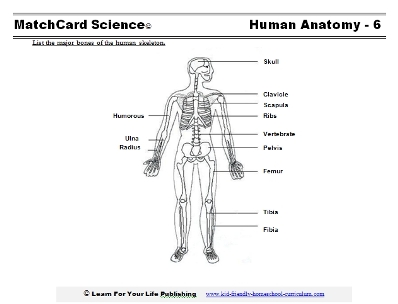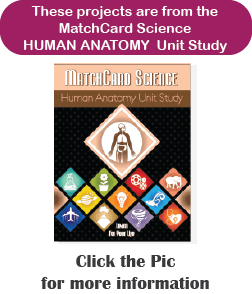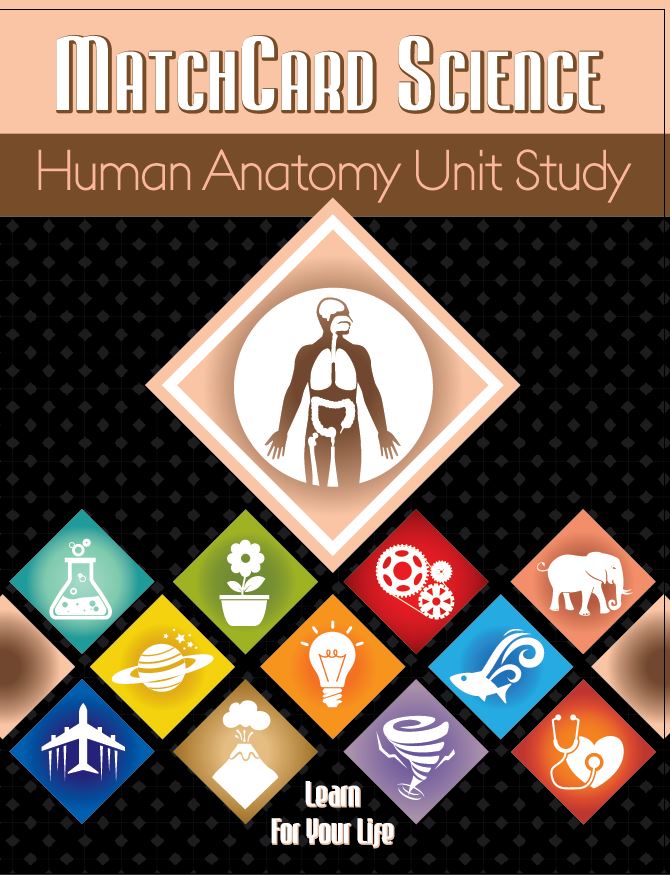Human Skeleton Diagram
Skeleton of the Human Body MatchCard
bones to the human skeleton diagram.
Free Download Below


Human Skeleton For Kids in 3rd to 8th Grade
Objective: List the major bones of the human skeleton.MatchCard Information Pieces list eleven bone of the human body skeleton using correct anatomical terms: skull, clavicle, ribs, vertebrae, pelvis, humerus, radius, ulna, femur, fibia, tibia.
Students match the bones to the human skeleton diagram on the MatchCard.
Download and Use the Human Skeleton and MatchCard
This is MatchCard #6 of the Human Anatomy Unit Study. Directions for using MatchCards are below.No Bones About It
Here is a warm up exercise to get your students interested in the human skeleton bones.- You will need pieces of paper for drawing. Large size paper will work better than standard sheets. If you can make it out of rolled paper the size of their own body, that would work best. Smaller paper will also work, however.
- Do this project before showing them the human skeleton diagram.
- Explain that the skeleton of the human body is similar in shape to the outside of the body - but not exactly. They are going to make a human skeleton diagram by feeling their own skeleton. Afterwards, they will compare it to a real diagram.
- Start with the head. Students should feel the shape of their head, then draw that shape on the paper. Encourage them to use the anatomic position. (See box) They may, however, draw the profile of the head, to make the shape easier to detect.
- If they have a life sized sheet of paper, they can attempt to draw the correct size. If not, try to fold the paper in eighths. The head of children is often 1/8 the size of the entire body. (Differs with age.)
- After they complete the head, move to the neck.
- Plan about ten to fifteen minutes for this project.
Skeleton Printout
Use the human skeleton diagram on the MatchCard or any other printable human skeleton for this next activity.It may add to the interest if you cover the diagram with another sheet of paper. As you go through the major bones of the human skeleton, bring the paper down to show each part.
Skull
Now that they see the diagram, let them feel the shape of their own skull again.Explain that the skull is made up of bones which are fused together so it feels like one bone in an adult and older child.
Only one part of the skull moves. Can they find out which one. (The mandible, or bottom jaw)
Neck and Spine
The neck and spine are made up of individual vertebrae.Have them feel each vertebrae on themselves. They can also watch the vertebrae become more pronounced as another person bends his or her neck or back.
Clavicle
The shoulders and clavicle are difficult to feel with all the muscles beneath the skin. Start with your hand on the shoulder socket. Move it inward, over the clavicle. Feel the bones as your shoulders are shrug.Ribs
How many ribs can you count while touching your own skeleton? (There are 12 pairs.) Some of the ribs attach to the sternum, or chest bone. Others are floating ribs that do not attach to the sternum.Look at the rib cage on the human skeleton diagram. Then look at diagrams of the respiratory system and the circulatory system.
Comparing the placement of the ribs to the heart and lungs demonstrates the importance of lungs in protecting vital organs. Think how dangerous it would be to play basketball, or any other sport, without our rib cage.
Pelvis
The pelvis is often referred to as the hip bones. It is actually an odd-shaped bowl that supports the internal organs of the trunk.Put your hands on your hips. You can feel the crest of the pelvic bones in the back.
The legs are attached to the front of the pelvis.
Scapula
The scapula is a triangular shaped bone in the back. It is often called a "shoulder blade."What does ithe scapula do? It attaches the upper arm to the clavicle.
It's hard to feel your own scapula. But you might be able to outline someone else's scapula. But be careful: they might want a good back scratch when you do.
Humerus, Radius, Ulna
The arm bones are the humerus, radius, and ulna. The humerus is the single bone at the top of the arm.Below the elbow, there are two bones. The radius is on the same side as the thumb. The ulna is on the same side as the little finger.
Turn your hand as if you were turning a door knob. You will notice that the radius radiates around the ulna. It is always the radius that moves while the ulna stands still.
Here's an activity that demonstrates the importance of the human skeleton for kids:
- You can move any bone or muscle in your body, except you cannot move the radius around the ulna.
- Practice moving while keeping the radius stationary.
- Now, try to do any simple activity without moving your radius:
- Tie your shoe.
- Brush your teeth.
- Write your name.
- Open the door.
- Drink of cold water, anyone?
Femur, Tibia, Fibia
The leg bones are the femur, tibia, and fibia. The set of three bones will be familiar after studying the arm.The femur is the thigh bone. It is the longest bone in the body.
The fibia is below the knee. It is on the outside. The tibia is on the inside.
(Need a hint to help you remember the tibia and fibia? If you fib, you will be left on the outside.)
Activities to Teach the Human Body Skeleton
Matching
Print the words to the eleven major bones on index cards.On other cards print their common names: (ie upper arm bone/humerus; head/skull; collar bone/clavicle; etc.)
Students can play memory, go fish, or other matching game with the pairs.
Simon Says
Here's my favorite way to review the human skeleton bones!Give commands such as:
- Simon says to touch your tibia.
- Put your scapula on the floor.
- Simon says to twist your radius.
Skeleton Print Out
You can print multiple copies of the Human Skeleton Diagram and MatchCard. In addition to the bones already mentioned, students can learn more:- Carpals
- Tarsals
- Patella
- Sternum
- Sacrum
Hands On Fun
Doing science is always more fun than reading about it.
Check out our resources for learning about the skeleton of the human body with our resources for human anatomy for kids.
MatchCard Science
How To Use MatchCards

Download the FREE MatchCard Science Instructor's Guide and see how MatchCards can make building their science knowledge base fun.
Human Anatomy Unit Study

Download the entire Human Anatomy Unit Study
12 Science Unit Studies

Chemistry is only one of twelve complete unit studies for kids in 3rd to 8th grade.
Comprehensive objectives, hands-on projects, suggested science fair experiments, and the fun game-like MatchCards keep them interested in learning science. See all twelve MatchCard Science Unit Studies.
About Our Site
Hands-On Learning














